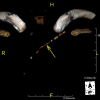Densities in the left innominate vein after removal of an implantable venous device: a case report
- PMID: 22747780
- PMCID: PMC3407751
- DOI: 10.1186/1752-1947-6-180
Densities in the left innominate vein after removal of an implantable venous device: a case report
Abstract
Introduction: Pericatheter calcifications are unusual and rare after removal of indwelling central venous catheters with few reports in the literature. We present a case of a woman with calcifications in her left innominate vein after removal of an implantable venous device.
Case presentation: A venous access port was surgically placed for intravenous chemotherapy in a 19-year-old Caucasian woman who had been diagnosed with acute lymphoblastic leukemia. She developed a fever three and a half years after placement, and the venous access port was removed as it was seen as the only focus for her fever. In the year following its removal, a computed tomography scan was ordered due to a clinical suspicion of deep venous thrombosis of her left arm. The computed tomography scan revealed a hyperdense structure in the left innominate vein with thrombosis. It was concluded that this was a foreign body, a retained catheter fragment after removal of the catheter. After three-dimensional reconstructions were performed, it was determined that these hyperdense structures were calcifications in the left innominate vein that resembled a foreign body.
Conclusions: Differentiating between intravenous thrombotic calcification and a retained catheter tip after removal can be challenging, even with modern day diagnostic tools. Care should be taken to document the length of the catheter upon placement and upon removal. In this manner, unnecessary surgical exploration can be avoided. We would like to highlight the importance of these diagnostic considerations for radiologists and oncologists.
Figures


References
LinkOut - more resources
Full Text Sources

